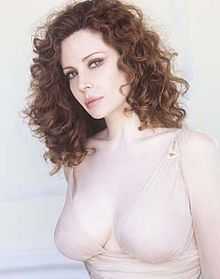Francesca Dellera

Francesca Dellera (born Francesca Cervellera on October 2, 1966 in Rome) is an Italian actress and model.
Life and career
After her high school degree in classical studies, Francesca Dellera started working as a model. Her beauty and allure graced the covers of national and international magazines. She was shot by world-class photographers such as Helmut Newton, Dominique Isserman, Greg Gorman, Micheal Comte as well as others. The authoritative fashion journalist Natalia Aspesi described Francesca Dellera in the following way: "When compared to the unsexy parameters that are part of the current times, Francesca Dellera is a young woman from a different era, her soft white skin is something one does not see anymore. Today, femininity is something flashy and without sex appeal as often portrayed in television or even in fashion".[1]
Dellera was launched by film director Tinto Brass, who chose her as main actress in Capriccio (1987).[2] The following year she had a great success with the TV miniseries La romana, directed by Giuseppe Patroni Griffi and opposite Gina Lollobrigida.[2][3]
La Romana was the television version of the film bearing the same name directed by Luigi Zampa. The film itself was based on the novel of the great Italian author Alberto Moravia, and in the television series, an audience of over 10 million watched Dellera in her lead role with Gina Lollobrigida (leading actress in the original film). Moravia was so charmed by Dellera that he decided to do an interview with her in the important weekly magazine l'espresso an honor that had been given to top actresses such as Claudia Cardinale and Sofia Loren. For her performance Dellera won the Telegatto award.
However, it was the 1991 film The Flesh directed by Marco Ferreri that Dellera reached international acclaim. The film entered the 1991 Cannes Film Festival. The director described Dellera as having "the most skin in Italian cinema". The film was successfully presented in Cannes. One of the most important Italian film critics Tullio Kezich said the following about Dellera : "Her physical allure speaks for itself. As an actress, she has something exceptionally special. She is so comfortable in front of the movie camera that when she is dressed, she seems nude, and when she is nude, she seems dressed".[4] Federico Fellini was so moved by her talent in Ferreri's film that he chose her for the role of the fairy for the film Pinocchio. Unfortunately, the film was never made due to the director's sudden death.[5]
Later she moved in Paris, where she had an affair with Christopher Lambert.[2][6] In 1994 she starred in Jacques Deray's L'Ours en peluche, alongside Alain Delon, then focused her appearances on TV-series.[2] Dellera was so widely appreciated in France that she is present in the book dedicated to the first fifty years of the Cannes Film Festival. She was later a catwalk model for Jean Paul Gaultier's collection. After having spent a number of years in France, she returned to Rome where she played the title role in Nanàa television mini-series directed by Alberto Negrin. The mini-series was based on the novel bearing the same name by Émile Zola. Later, she had the lead role in the TV film La contessa di Castiglione (that was also part of a French co-production Josée Dayan). Dellera acted with Jeanne Moreau in this film. She also appeared in several advertising campaigns.
Filmography
- Grandi magazzini (1986)
- Capriccio (1987)
- Roba da ricchi (1987)
- La romana (1988)
- La bugiarda (1989) (TV series)
- The Flesh (1991)
- L'ours en peluche (1994)
- Nanà (1999) (TV series)
- La contessa di Castiglione (2006) (TV)
References
- ↑ Nevio Boni (16 July 1996). "Francesca, l'ultima donna bambina". La Stampa. p. 25.
- ↑ 2.0 2.1 2.2 2.3 Stefano Masi, Enrico Lancia. Les séductrices du cinéma italien. Gremese Editore, 1997.
- ↑ Peter Cowie (Andre Deutsch, 1992). "Variety international film guide , Volume 2006". Check date values in:
|date=(help); - ↑ Tullio Kezich (6 November 1988). "Francesca Dellera, una splendida Adriana". La Repubblica. p. 25. Retrieved 25 March 2013.
- ↑ Alessandro Casanova. Scritti e immaginati: i film mai realizzati di Federico Fellini. Guaraldi, 2005.
- ↑ L'Espresso. Editrice L'Espresso, 1996.